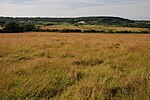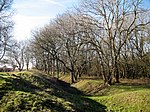Weston in Gordano
Civil parishes in SomersetUse British English from October 2013Villages in North Somerset

Weston in Gordano is a village and civil parish in Somerset, England. It is situated in the middle of the Gordano valley on the north side, and in the Unitary Authority of North Somerset, on the road between Clevedon and Portishead. The parish has a population of 301.It is the largest village in the valley, with a public house, the 18th century White Hart, and a garage.
Excerpt from the Wikipedia article Weston in Gordano (License: CC BY-SA 3.0, Authors, Images).Weston in Gordano
B3124,
Geographical coordinates (GPS) Address Nearby Places Show on map
Geographical coordinates (GPS)
| Latitude | Longitude |
|---|---|
| N 51.464 ° | E -2.7911 ° |
Address
B3124
BS20 8PG , Weston-in-Gordano
England, United Kingdom
Open on Google Maps










